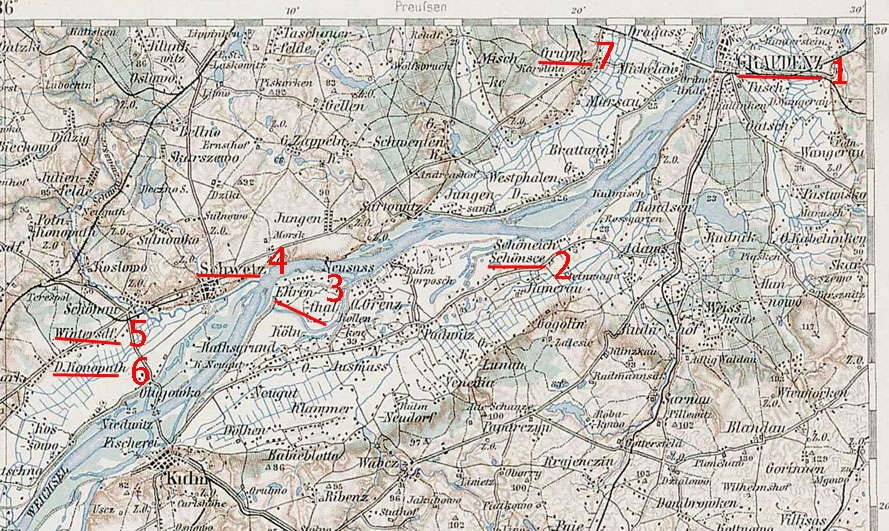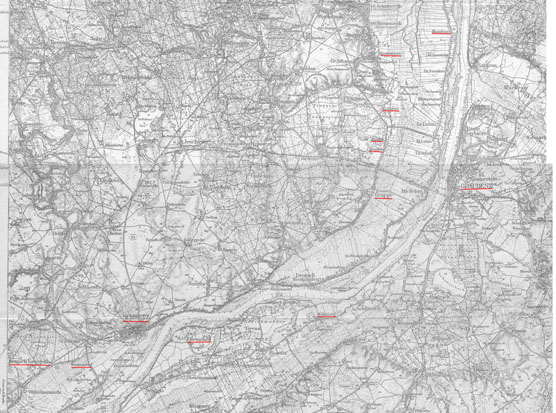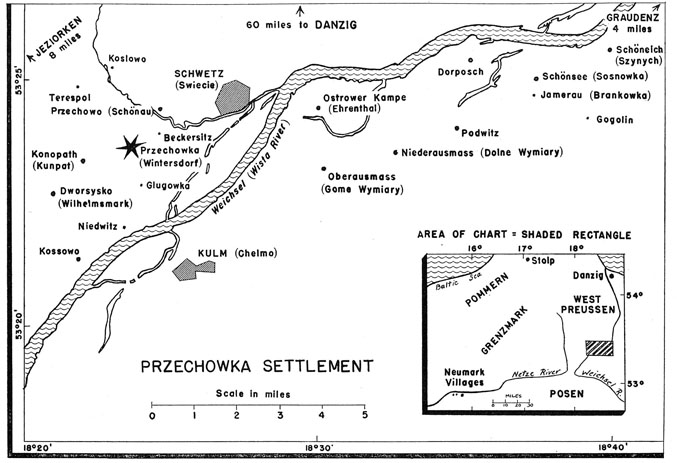Schwetzer Niederung
"Schwetzer Niederung" is German for the Schwetz Lowlands. In this region, a few of the more important Mennonite congregations which ended up in Russia and then America were formed as original congregations. These included: Montau, Przechowka, pronounced Pshe-khof-ka, and Schönsee. Besides these villages which served as the meeting places, Mennonites lived in many surrounding villages, the most prominent being: Konopat, Graudenz, Ostrovo Kaempe, and Kommerau.
The first map is specific to the Mennonite settlements.
The second and third maps are more detailed, professional, and published as official maps under ruling government.
Then follow entries, in whole or part, from the Mennonite Encyclopedia [www.gameo.org]. Further information about these locations will be added from www.holland.org.pl .
 [1] |
 |
Click photo for full size [2] |
Further up Vistula
As the land in this triangle became occupied the descendants and newcomers proceeded south along the Vistula River, establishing themselves in Schwetz, Graudenz, and Culm.” [5]
Schwetzer Niederung (Kuyavian-Pomeranian Voivodship, Poland)
Schwetzer Niederung (Lowlands near Schwetz), a district (starostei) on the Vistula in West Prussia, until 1772 belonging to Poland. Dutch colonists reclaimed this swampy area in the 16th and 17th centuries. In the Schwetzer Niederung were found the villages of Deutsch-Westfalen, Brattwin, Schönau, Kleinsee (Jeziorka), Neunhuben, Wintersdorf, Christfelde, and Kossovo. Wintersdorf (Przechovka), was the first Mennonite settlement (ca. 1540). About 1650 there was a considerable number of Mennonites in all these villages, and some villages were completely Mennonite. Until the early 18th century the Mennonites enjoyed many privileges such as the freedom to organize their own schools, and exemption from military taxes and quartering soldiers. By their able land-draining and their skillful farming the Schwetzer Niederung be came very prosperous, but repeated floods, exploitation by the rulers and officials, and restrictive economic regulations caused the Mennonites to move away from 1765 to 1850 (to Brenkenhoffswalde and Deutsch-Wymysle); by 1850 all the Mennonites had left this area.
Montau (Kuyavian-Pomeranian Voivodship, Poland)
Montau (Polish Matawy), a Mennonite congregation in former West Prussia, near Neuenburg (Schwetz district). According to documents preserved in Danzig (now Gdansk) this settlement had existed since 1568, for on 2 February 1568 a number of Dutch Mennonites had moved in from the Danzig Werder—Thomas and Peter Jansen, Leonhard von Rho (garbled; probably Leenaert van Rhoon), Bernhard von Baygen (Berent van Bargen), Andreas (Andries) Unrau, and their companions and relatives—and concluded a rental contract with Hans Dulzky of Roggenhausen; it included the villages of Montau and Sanskau, an area of 50 hooves. The further settlement of the Schwetz-Neuenburg lowlands apparently radiated from here. The documents also indicated the Dutch origin of the settlers. Other evidence of this origin was seen in the architecture and in the Dutch Bibles preserved in some of these homes. Dutch was the language used in preaching until the 18th century. Later, when the Mennonites spread over the entire lowland, a subsidiary church was built at Obergruppe in 1776.
In course of the 16th and 17th centuries there were several additional immigrations from Holland. The Montau group was the first to settle near the left bank of the Vistula River, and gradually spread out over a wide area; as early as 1598 a number of Mennonites from Montau settled near Sanskau to begin the cultivation of this area. Others settled at Gruppe, Deutsch-Westphalen, Gross-Lubin, Neunhuben, Dragass, all in the neighborhood of Montau. In the late 18th century some of its members moved to Brenkenhoffswalde and to Deutsch-Kazun. The area of Montau was in the 17th and 18th centuries struck by various calamities. About 1620 the Mennonites had some difficulty with the governors, but in 1623 obtained freedom from military service and quartering. About 1657 during the Swedish-Prussian war Mennonite property was severely damaged by the passing armies; the floods of the Vistula repeatedly damaged the fields and the houses, particularly in 1677, when a number of farms were destroyed and many people and cattle perished, and many fields were ruined by the sand washed over them. A few years later they suffered a total crop failure. In 1727 the passing armies (Polish, Saxon, Swedish, Russian) plundered the farms to such an extent that they had to sell some of their land to pay their taxes. After 1772, when this area was occupied by Prussia, conditions were somewhat improved; but during the Napoleonic wars (1806-1815) the congregation again suffered severely. In many of their tribulations the Montau Mennonites were financially supported by the Dutch Mennonites.
In the 16th-18th centuries the Montau congregation belonged to the Frisian Mennonite branch. At a conference held in Montau in 1568 delegates from Danzig, Elbing, the "Kleine Marienburger Werder," Montau, and Thorn resolved to side with the Frisian party in the Netherlands. The first elder was very probably Hilchen Schmidt (Hylke Smit), who was commissioned by the Haarlem congregation in 1588 to depose Quiryn van der Meulen from the office of elder in Danzig.
For centuries the congregation held to the old doctrines and practices, including nonresistance. The North German law issued on 9 November 1867, threatening to deprive the Mennonites of their old privilege of freedom of military service also confused the congregation in Montau. After much correspondence and several audiences at Berlin, the church council accepted a new church constitution drawn up by Elder Peter Bartel, which permitted members to accept noncombatant service, as offered by the Order of Cabinet of 3 March 1868, but threatened to excommunicate those choosing military service; this was, however, never carried out. The question of military service caused the Obergruppe congregation to split off from the Montau church in 1869; the new group refused to tolerate soldiers as members, whereas the Montau congregation did not exclude such members. In 1920 the breach was healed, and the combined brotherhood was then called the Montau-Gruppe congregation.
Przechovka (Kuyavian-Pomeranian Voivodeship, Poland)
Przechovka (Przechowka, German, Wintersdorf), West Prussia (now Poland), was formerly the seat of an Old Flemish congregation, the mother congregation of the Brenkenhoffswalde congregation in the Netzebruch and of Alexanderwohl and Gnadenfeld, the leading congregations in the Molotschna Mennonite settlement. It was situated inland from the villages of Deutsch-Konopath and Divorczieka (German, Wilhelmsmark) and along the Vistula River with the villages of Glugovka, Kossovo, and Christkovo (German, Christfelde), southwest of Schwetz with Ostrov (German, Ehrenthal) up the Vistula in the Klein-Schwetz marsh, south of the Frisian communities of Montau-Gruppe and Schönsee. Przechovka and Divorczieska were royal villages, Deutsch-Konopath, Kossovo, and Christkovo noble villages, Glugovka part royal and part noble. The settlements are thought to have originated about 1540; in 1661 they were a part of the Groningen Old Flemish Sociëteit, which held most tenaciously to the old traditions. In the 18th century there were settlements of Old Flemish to the northwest in the noble villages of Jeziorka (German, Kleinsee), straight north in Tuchel, and northeast across the Vistula in Schönsee, Posterwolde, Horst, Ausmass, Jamerau, and Dorposch.
The estate of Przechovka was originally sold to five Mennonites from the Netherlands by the heirs of a Polish nobleman; these settlers attracted other Anabaptists, so that the village community finally embraced 15 home sites. The first contract of lease was granted to the village in 1642 for 50 years. In 1653 there was an association of Dutch inhabitants for the support of the schoolteacher, the burial of members of other faiths; in 1668 a "Manist Johannes" touched his breast as affirmation instead of an oath. The privilege granted by John II Kasimir was confirmed a number of times; on 9 February 1672, it was confirmed expressly for Przechovka, Kossovo, and Christkovo.
Under the leadership of Peter Wedel and Heinrich Buller most of the Mennonites left in the Schwetz area emigrated to the Molotschna Mennonite settlement in Russia in 1819-1820 and 1823-1824, and founded the Alexanderwohl congregation. Concerning the end of the congregation Stobbe reports: "The meetinghouse was in the present school yard. . . . In 1832, when the town of Przechovka built its own school and wanted to rebuild the Mennonite meetinghouse for that purpose, the few remaining Mennonites opposed the move and sold it to be dismantled. What happened to the meetinghouse cannot be ascertained, since the records of the town were destroyed by a fire in 1857. The last elder was a Richart and lived in Deutsch-Konopath. The congregation that at the end of the 18th century had about 300 members was extinct by about 1830. The few remaining old Flemish united with the Frisians in 1849."
Schönsee (Pomeranian Voivodeship, Poland)
Schönsee (Polish, Sosnovka), a village in Poland, from 1772 until 1919 belonging to West Prussia, Germany, situated ten miles north of Culm about two miles from the right bank of the Vistula River, where Mennonites from the Netherlands settled as early as 1553 to reclaim and drain the swampy lands along the Vistula, being the first Mennonite settlement in the Culm region. The first land lease is lost, but a second one, of 1594, between the city of Culm, to which this territory belonged, and the farmers, still exists. In this and following leases only farming was allowed to the settlers; no handicrafts were permitted except weaving, tailoring, and shoemaking for private use. They were allowed to fish in the Vistula. The settlers, who lived at Schönsee and also in the surrounding villages and hamlets such as Jamerau, Dorposch, Lunau, and Schöneich, were explicitly granted the privilege of free exercise of their religion, including teaching in schools. The following Mennonite families are named in the land leases in 1695 and after: Unrau (Unruh), Siefert (Siebert), Hube(?), Block, Voth (Foth), Funk, Jans (Jantz), Buller, Köhn, Sperling, Stephan (Stevens, Steffens), Wilhelm (Willems), Boltz (Bolt), Stob (Stobbe), Tomasche (Thomsen), Meister, Decker, Penner, Brümmer(?), Mentz, Schümann (Schoman), Frantz, Abraham (Abrams), Pödker (Boetscher), Voutsche(?), Siedau(?), and from 1725 also Nickel, Bartel, Schröder, Nachtigal, Weitgraff (Weidegraf), Pancratz, Arndt (Arentsz), Eckert (Eggert), and Plener (Plenert). Besides these there are found in the list drawn up by Elder Hendrik Berents in 1719 the names of Schellenberg, Isaack, and Riggers (Richert). Since a number of these names are not Dutch-Frisian, other settlers must in the meantime have joined the original settlers.
As early as about 1570 there were two Mennonite congregations at Schönsee, one Flemish, whose meetinghouse was called "die kleine Schule" (small school), which sided with the Groningen Old Flemish, and one Frisian (also called Waterlander), whose meetinghouse, built in 1618, was called "die grosse Schule" (large school). They are small and very plain buildings (pictures in Siedlungswerk taken in 1940-41).
Concerning the early history of the Mennonites of Schönsee there is not much information. Social and religious development seems to have been favorable in the 16th and 17th centuries. Sometimes they were struck by calamities like floods and crop failures, but their tenacity and energy, and aid from their benevolent landlords, the city magistrates of Culm, easily overcame their blows. Both congregations of Schönsee were small in membership; the Frisians, concerning whom there is no further information, formed the larger one; in 1719 the Flemish numbered 48 baptized members. This Old Flemish group then belonged to the same congregation as Przechovka (Wintersdorf) and Konopath on the left bank of the Vistula in the territory of Schwetz, and Posterwolt on the right bank. Although Schönsee was a part of this congregation, it obviously had its own preachers by this time. In 1760 a separation was made for practical reasons.
In 1765 a number of Old Flemish Mennonites from Przechovka and Schönsee moved to Brenkenhoffswalde and Franztal in the Neumark; others emigrated to Deutsch-Kazun about 1780 and still others to Volhynia in the early 19th century. These emigrations appreciably decreased particularly the number of Flemish Mennonites in this area.
The Dutch Naamlijst from 1743 to 1802 also names the ministers in the Schönsee congregations. In the Old Flemish congregation the ministers were Laurens Sperling, elder 1760; Peter Pancratz, preacher 1760; Jacob Wedel, preacher; Peter Jantz, preacher 1773; the Naamlijst of 1780 names only Peter Pancratz; in 1786 Pancratz is missing; the preachers are Benjamin Wedel and Tobias Jantzen, both appointed in 1785. The list of ministers of the Frisian congregation is more complete; they were Peter Dirks before 1743-ca.1758; Gabriel Frantz, Sievert Tjart, Jan Siebrandt before 1743-ca.1750; Peter Nickel before 1743-ca.1780; Cornelis Frantz, elder ca.1750-1758; Andries Gertz, preacher ca.l750-1762; Hendrik Cornelissen 1757-1759; Peter Tjart 1757-1762; Gertgen Knoop 1759-ca.1781; David Battel ca.1752-1765; Cornelis Frantz, preacher 1763, elder 1776-ca.1788; Heinrich Siebrandt 1786-? ; Peter Baltzer 1771-ca.1796; Jacob Gertz 1775-ca.1798; Heinrich Tjart 1788-after 1802; Timotheus Boltz 1788-after 1802; Jacob Frantz, preacher 1791, elder 1794-after 1802.
On 12 October 1849, the small Old Flemish congregation of Schönsee, then numbering 39 souls, merged with the Frisian congregation. The Flemish meetinghouse was abandoned; the old Frisian meetinghouse of 1618, somewhat remodeled, was used until 1945.
Konopat (Kuyavian-Pomeranian Voivodeship, Poland)
Konopat (Konopath, Konopat in Polish) was located near Przechovka (Wintersdorf) in the district of Schwetz, on the Vistula River, in West Prussia. It was a village where Mennonites lived (in 1772 one-third of the population was Mennonite), who, together with those of Przechovka, formed a congregation of the Groningen Old Flemish branch. ...1700 and 1719...In this list well-known West Prussian names are found, such as Raatslof (Ratzlaf), Tesmer, Nagtegaal (Nagtigal), Voet (Foth), Smit (Schmidt), Jans, Jansen, Boeler (Buhler), Isaachs, Onrouw (Unruh). In 1719 the group of Mennonites at Konopath (in the Dutch sources called Kunpad or Koenpat) numbered 52. This congregation, regularly found in the Dutch Naamlijst, emigrated to the Molotschna Mennonite settlement in South Russia in 1819-1820 and 1823-1824.
Graudenz (Kuyavian-Pomeranian Voivodeship, Poland)
After the devastating floods of the Vistula River about 1560, large areas of the territory of Graudenz were depopulated. This stricken territory was then largely taken over by Dutch settlers, usually Mennonites, who were granted the privileges of freedom of religion, their own schools, and transporting their products on the Vistula free of taxes. In the 17th century Mennonites predominated in the following villages: Parsken, Kommerau, Klein-Lubin, and Dragass; they were very numerous in the villages of Klein-Wolz, Tresch, Gross-Lubin, and Klein-Lubin.
In Graudenz and its vicinity there were until 1945 numerous Mennonites, especially in the congregations of Montau, Gruppe, and Schönsee. In the "Consignation" of all Mennonite families living in "West Prussia" in 1789 (thus outside the city of Danzig and the region of Thorn, both of which were ceded to Prussia in 1793 in the second partition of Poland).
Graudenz was the scene of the memorable meeting between Frederick William III of Prussia and Abraham Nickel of Jamrau, the deacon at Culm (Schönsee), 8 October 1806 in the "gouverneur" house, later a school, Nonnenstrasse 5 at the Luisenbrücke.
Ostrovo Kampe (Poland)
Ostrovo Kampe, near the hamlet of Ehrental, situated on the east side of the Vistula in Poland, was settled by Mennonites, who were members of the Przechovka Old Flemish Mennonite congregation and had their own Mennonite school in the Ostrovo Kampe. Repeatedly struck by floods, most of them left this area about 1765, settling in the Netzebruch, while the remainder in 1821 moved to Russia and settled at Alexanderwohl.
Kommerau (Grudziądz, Kuyavian-Pomeranian Voivodeship, Poland)
Kommerau (Polish, Osiec), a hamlet on the left bank of the Vistula River in the district of Graudenz, where on Polish territory (after 1772 German) Dutch Mennonites founded a settlement about 1570. Land leases of 1604, 1656, 1684, and 1773 have been preserved. In 1623 the Mennonites of Kommerau obtained exemption from military taxes and quartering of soldiers.
[Back to Danzig] [Next to Mazovia]
Sources
[1]. Duerksen, J.A. "Przechowka and Alexanderwohl: Beginnings of Alexanderwohl, Tabor, Huffnungsau and Other Churches." Mennonite Life. 10.2 (1955): 76-82.
[2]. Karte des Deutschen Reiches 1:100.000
[5]. Krahn, op cit.
Further Reading
(Digital copies available on request)
Goertz, Adalbert. "Research Note: The Marriage Records of Montau in Prussia for 1661-1704." Mennonite Quarterly Review. 240-250.
Return To Histories Page
Return To Home Page
© 20011 Daniel Foote. Based on Template Designed by Andreas Viklund.
